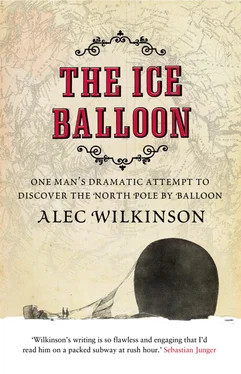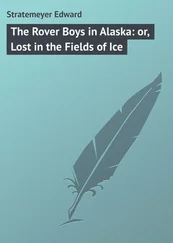
S. A. Andrée
Courtesy of the Grenna Museum, Sweden (www.grennamuseum.se)/The Swedish Society of Anthropology and Geography.
Because I would have chafed at such dramatized talk, however fervent or earned, I imagine Andrée as waiting impatiently to speak. He was thirty-nine, blond, tall, and well built, with wide shoulders and a strong jaw. A woman in the audience described him as “heroic-looking.” An acquaintance portrayed him in a letter as “a worthy descendant of the old Vikings.” When he felt something passionately, he wasn’t above rhetoric, and he liked the long run-up. In his Swedish accent, words such as “have” came out “haff.”
“The history of geographical discovery is at the same time a history of great peril and suffering,” he began. “While forcing their way through unknown regions across the vast deserts of Australia, Asia, Africa, the prairies of North America, or through the forests of South America and Central Africa, the explorers have encountered dangers, endured hardships, and been obliged to conquer difficulties, of which no clear idea can be formed by those who have never passed through similar experiences.”
In warm climates, however, “nearly every hindrance can be said to contain a means of success.” Natives often “bar the way of the explorer, but just as often, perhaps, they become his friends and helpers.” Lakes and rivers carried him places; plus he could drink from them and find in them things to eat. In the desert, despite the harsh sun, there could also be “a luxuriant vegetation that serves as a shelter,” not to mention people who have been where you are going and can tell you the best way to get there.
In the Arctic, “the cold only kills,” Andrée continued. There were “no oases in the icy desert, no vegetation, no fuel,” just “a field of ice that invites to a journey,” but this field, “covered with gigantic blocks,” had proved too daunting to cross. The current might lead a vessel forward, but only into waters filled with ice that crushed ships, and in the high reaches of the Arctic desert, no natives were around to help you. The sun lit one’s way in the summer, but it also rotted the ice so that your sledge balked and bogged down and with each step you might sink to your knees. Only by considerable toil could you advance, and then only farther into a landscape that had no comforts or shelter.
“If we further remember that the Arctic explorer can engage in active traveling during a brief season only,” Andrée said, “and that during the remainder of the year he is compelled to inactivity under the weakening influence of cold, together with darkness, while he has to resort to the nourishment that is usually unsuitable and often insufficient, and that is always haunted by the consciousness, that the results he can attain will almost inevitably be meagre in comparison with those which can be secured by explorers in other parts of the globe; then it must be admitted that Arctic research offers drawbacks which are materially greater than those encountered by geographical explorers in other places.”
Laying out his case, Andrée went on—perhaps incautiously—to malign the sledge, the only means for Arctic travel that had “hitherto been used or even been available for use.” Whether drawn by dogs or men, it had failed to carry anyone far enough, “although new efforts to make them a success have repeatedly been made. The fact remains that, in the attempts made for centuries to cross the polar ice, numerous lives and vessels have been lost and large sums of money wasted.”
No nation took greater pride in its sledging or its sledgers than Britain, and no nation had lost more of them. Perhaps Andrée was giving the same speech he had given in Sweden, where sledging was not so revered. Possibly he didn’t care what the British thought. Or maybe, as his friends sometimes said, he had a tin ear and didn’t understand the effect his remarks might have. It requires little of the imagination, however, to hear throats being cleared and feet shuffling.
Nevertheless, Andrée was now at the hinge of his speech. “It would seem,” he went on, “as if it were about time to look into the matter carefully, with a view to ascertaining whether there is no other means of transportation than the sledge available for a journey in the regions referred to. We need not pursue the investigation very far to discover such a means, one that appears to be created for the purpose in question. I refer to the balloon.”
The perfect and navigable balloon, “which is worshipped because nobody has ever produced one,” was not what was needed, he said. The version at hand would suffice—people weren’t aware of how suitable it was because, more than seeing its advantages, they were accustomed to noting its defects. “Such a balloon is capable of carrying an exploring-party to the pole and back again,” Andrée said. “It is possible, with such a balloon, to cross the Arctic plains.”
His purpose declared, he now needed to persuade, and he softened his tone. “To make a journey across the Arctic deserts, is not a purely scientific, but a technical problem.” The results of such a voyage were important for science, but the means must be devised by the engineer. A balloon to reach the pole needed to carry three people, he continued, all the instruments they required for scientific experiments, and their food. It should be able to remain aloft for thirty days (the record was fifteen), and, unlike all balloons thus far known, it had to be able to be steered. Last, it had to be inflated in the Arctic.
A larger balloon, with sufficient lift, had been built and displayed in 1878 in Paris at an exhibition, where it made fifteen hundred ascents, each time carrying thirty or forty people, Andrée said. Since then a number of balloons had had the carrying power that the Arctic balloon required. “It is evident that the problem involving the manufacture of a balloon that will satisfy requirement No. 1 has long since been solved by the arts,” he said.
Balloons had also been made that retained gas long enough to suggest that a thirty-day flight was achievable. The hydrogen could be manufactured at the launching place or brought in canisters aboard ships. To prevent the wind from interfering with the balloon while it was being filled, a shed could be built as a hangar. Finally, the difficulty in sailing a balloon to a specific destination was that conventional balloons could travel only where the wind blew. A balloonist might take to the air hoping to be carried by currents to where he wanted to land, but the currents could change on him. Andrée announced that he had designed a system using guide ropes and a sail that had allowed his balloon to travel at cross-purposes to the wind.
Next Andrée described the attributes of the balloon he needed. The basket should be “spacious and comfortable,” have floats attached, and be hung from the balloon in such a way that it could be disengaged quickly, possibly by pulling a single rope. “The occupants will thus be able to save themselves at sea, when a vessel heaves in sight, by descending to the surface, and, if a heavy wind is blowing, ridding themselves of the balloon.” (Such an escape was possible only if a ship was seen. When asked what he would do if his balloon came down in the water with no one around, he said, “Drown.”) The balloon should also carry “a sledge, a canvas boat, a tent, arms and ammunition, and provisions for four months, all with a view to making a rescue possible in case of a mishap.”
To build the balloon and equip the expedition would cost about thirty-eight thousand dollars. The balloon would travel approximately 250 meters above the ground—below the clouds, that is, and above the fogs. It should start as close to the pole as possible, and as early in July as a brisk and steady south wind arrived. A moderate wind would be better than a powerful one, since the ground would pass in a more regular way, and more of it could be added to the map. “The stay in the unknown regions should be of such long duration as circumstances will permit,” he said, “and if chances to visit the surface should occur, they must be improved,” meaning acted on.
Читать дальше













